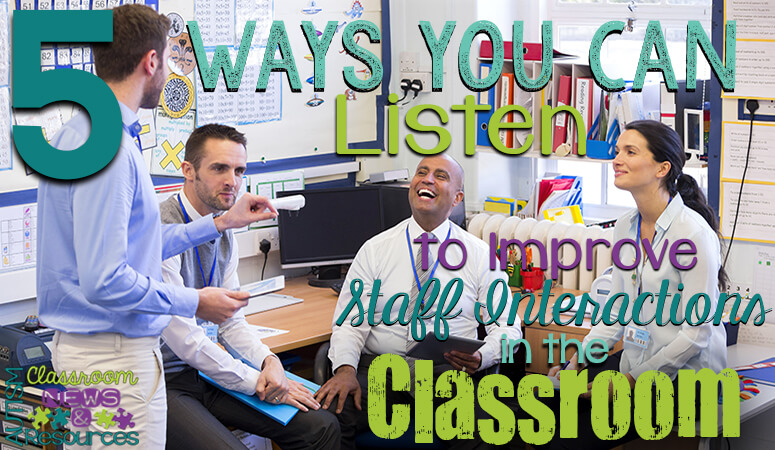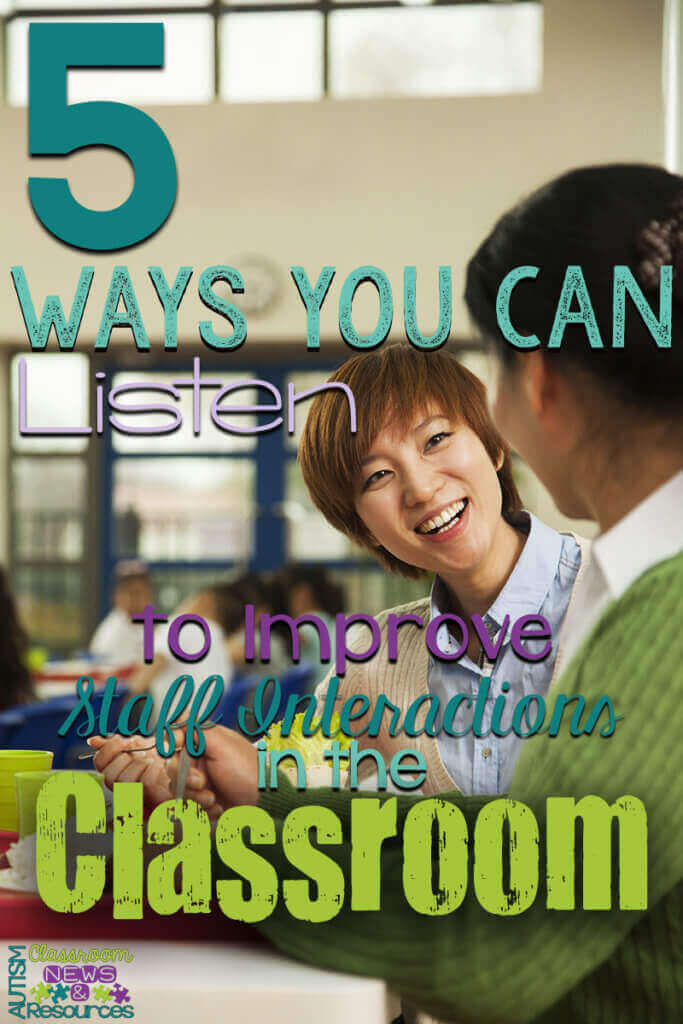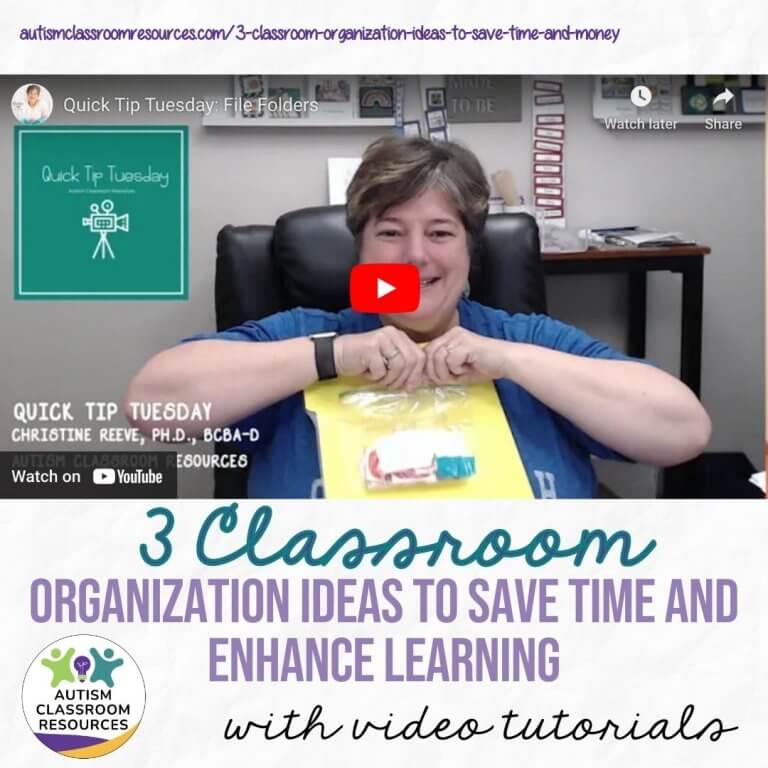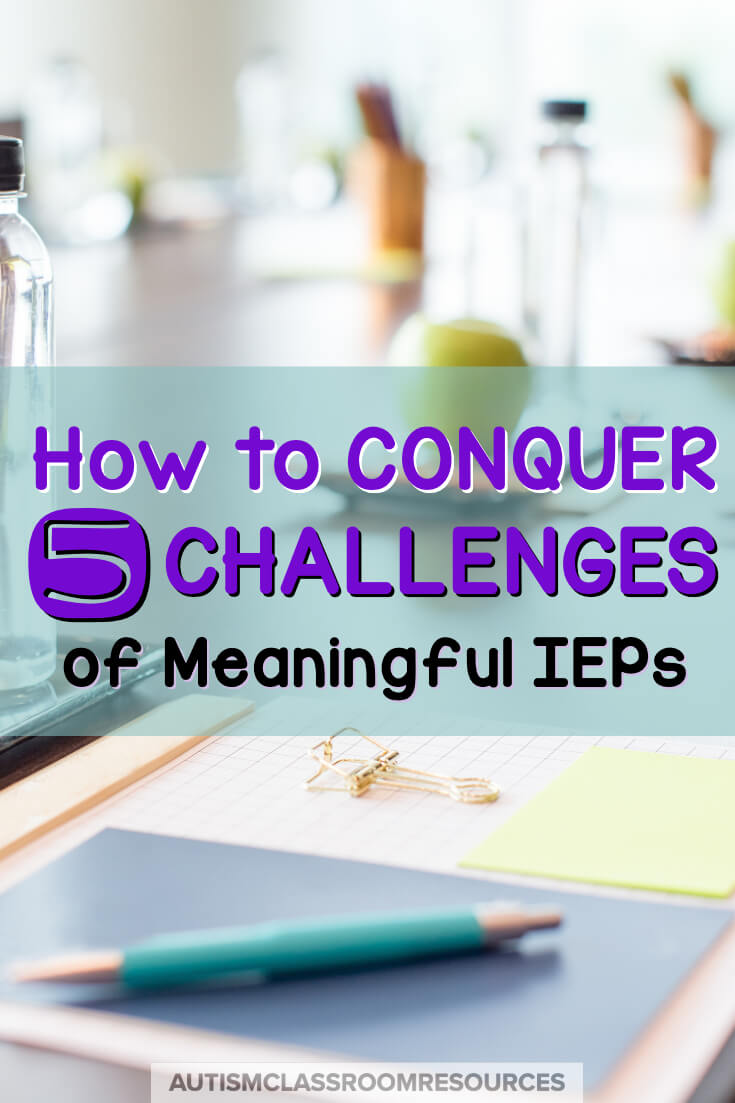Sharing is caring!
Effective listening is a much harder task than we always realize, particularly in our day-to-day life in a special education classroom. In my last post, I talked about giving feedback effectively to staff so they will listen. Part of building a relationship in which you can give meaningful feedback involves that you are also listening to others. Like observation and feedback, good listening is probably 1 part internal and 2 parts external. In other words, it’s 1 part actually taking in the information and it’s 2 parts visibly attending and reflecting so the other person knows you are listening to them.
Being a good leader in the classroom means that you are also good at listening and incorporating feedback from the others in the classroom, regardless of their position. Effective classrooms run on collaboration and teamwork and those things only happen when everyone has an active role and contribution. Part of building that collaboration and those relationships is through good listening. So, today I want to set out 5 things you can do to listen to improve staff interactions in the classroom, and help others on your team recognize you are hearing them.
5 Things Effective Listeners Do
1. Listen With Your Whole Body
Make sure that your body is reflecting that you are listening. You don’t need to make eye contact all the time the person is talking (cause really, that’s just creepy), but regular checking in with eye contact is important, especially when the topic is emotional. Keep your body open and not closed off by sitting slightly forward in your chair, keeping your arms uncrossed, stay relaxed (even if you aren’t), and watch your facial expressions. This means don’t shake your head while the person is talking because you disagree with them….you can share that later…right now you are listening. If you immediately dismiss what they say, they are not going to feel heard. Don’t roll your eyes and keep your expression neutral. You can nod occasionally to reflect that you are hearing them and attending. Put your phone away and don’t let it disturb the interaction unless you have a possible emergency (in which case preface the conversation with that statement). Essentially do what we teach our students to do when they do Whole Body Listening.
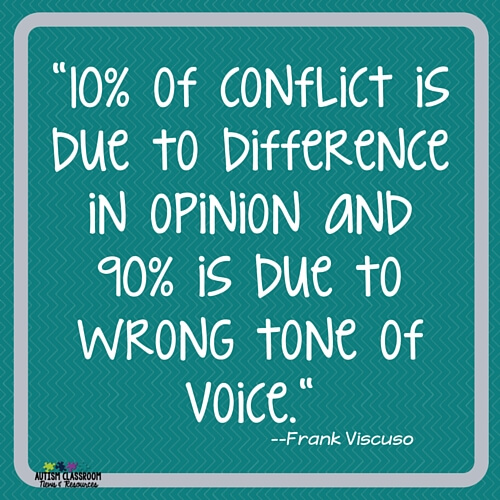
2. Suspend Judgment
Try not to focus on what you THINK about what the person is saying. Just listen. Put your feelings aside and just listen to what the other person is saying. Sometimes being heard is more important than being right or making a change. Changes are sometimes easier if you know people know where you are coming from. It’s tempting to start to think about all the reasons what this person is saying is wrong, but then you are not listening. If you are actively listening, you are putting aside your opinions and truly considering someone else’s ideas.
3. Watch The Other Person’s Nonverbal Cues
What are the nonverbal cues of the other person telling you while you are listening. Observe their body language and the way they are stating things. Do they look nervous? Do they look angry? Are they excited? You have to take those feelings into account to determine how invested they are in what they are talking about. Part of the message they are conveying is nonverbal…it’s the emotion of what they are saying more than the actual words.
 For instance, let’s say Jaimie wants the classroom to do more art activities. You don’t really like art, so you don’t have much art in the classroom and often consider it a waste of time. Jaimie is telling you all about the things that the students can learn during art and how she loves to conduct and plan art activities for students. In watching Jaimie talk about art in the classroom and things she’s done before, you started out thinking that it was just a case of “in my old class this is the way we did it.” However, when you are watching her talk about it, you observe how excited she is–her face is lighting up, she’s moving her hands and she’s smiling while talking. If you were just listening to her words, you would miss the fact that Jaimie clearly wants to be in charge of something in the classroom and contribute and she thinks she can contribute through planning art projects. Consequently, rather than dismissing her interest as a reluctance to do things the way you do them instead of the last teacher, you realize that maybe she would like more substantial ways to contribute to the classroom. So, you might consider doing more art activities that Jaimie plans and runs. Or you might decide that art isn’t the right fit for your classroom right now, but you might find other activities that Jaimie could put her passion into because by listening with more than your ears you realize that is what she is asking more than just a suggestion about art.
For instance, let’s say Jaimie wants the classroom to do more art activities. You don’t really like art, so you don’t have much art in the classroom and often consider it a waste of time. Jaimie is telling you all about the things that the students can learn during art and how she loves to conduct and plan art activities for students. In watching Jaimie talk about art in the classroom and things she’s done before, you started out thinking that it was just a case of “in my old class this is the way we did it.” However, when you are watching her talk about it, you observe how excited she is–her face is lighting up, she’s moving her hands and she’s smiling while talking. If you were just listening to her words, you would miss the fact that Jaimie clearly wants to be in charge of something in the classroom and contribute and she thinks she can contribute through planning art projects. Consequently, rather than dismissing her interest as a reluctance to do things the way you do them instead of the last teacher, you realize that maybe she would like more substantial ways to contribute to the classroom. So, you might consider doing more art activities that Jaimie plans and runs. Or you might decide that art isn’t the right fit for your classroom right now, but you might find other activities that Jaimie could put her passion into because by listening with more than your ears you realize that is what she is asking more than just a suggestion about art.
4. Paraphrase and Reflect
The more difficult the interaction is, the more this step is. Periodically throughout the discussion, it is important to make sure you are understanding what is being said. If the conversation is emotionally difficult, it’s even more important because emotions cloud judgment on both sides. It’s hard to say exactly what you mean when you are feeling overwhelmed, or angry or upset. It’s hard to listen closely when you feel that way as well. So, you can suspend your judgment and put your own emotions aside, but it is helpful to periodically use phrases that show you heard what was said and clarify it.
- So, what I heard you say was that you really want to be in charge of art activities in the classroom?
- So, I see you are very invested in this type of activity and I would love to to find something we can channel that passion into.
- It’s great to see you so excited about something.
- I am hearing that you are upset because you feel that the other aides are not cooperating.
- I heard you say that you don’t think you are a good match for working with Sally.
- I am glad you are sharing this information with me. Based on what you have said, it sounds like you are really struggling to focus on the positive aspects of the job.
- So it sounds like you are frustrated/upset/angry with X because Y
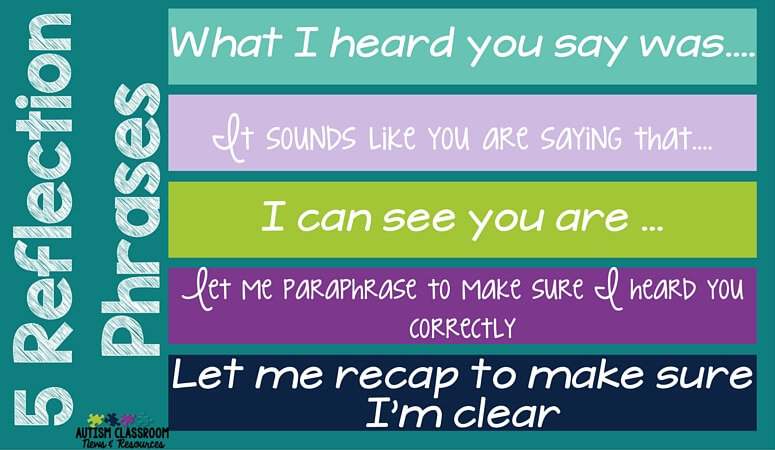
5. Validate What the Other Person is Saying and Feeling
Even when you disagree with someone, like not wanting more art in the classroom, you can validate what has been said. Instead of simply saying “I don’t think we need to have more art in this classroom for this group of students,” you might focus on Jaimie’s passion she is conveying about planning activities for students that get them engaged and think of some ways that she can use that energy in an existing activity. Even if you can’t solve a problem, you can validate the emotions behind it and let the person know he/she has been heard. For instance, it might sound like these examples.
I can see that you are very upset with Mindy [the other aide in the classroom] because you feel like she is telling you what to do. I can’t necessarily change Mindy’s behavior toward you, but I can talk to the whole staff about the importance of working as a team and respecting each other. I can use examples when I talk to everyone about the need to recognize that we are all in charge and all on the same side. Then I want you to know that I don’t expect you to do something just because Mindy says to do it. I will also try to clarify the zoning plan duties so it is clearer who is responsible for which duties in the classroom.
I can’t keep Mindy from bossing the other aides around…and even if I’m addressing this with Mindy it would be inappropriate to share that information with the other staff because it would be a violation of privacy for Mindy. However, I can validate what I’m hearing (whether or not I think it’s true–perhaps this aide just has it out for Mindy) and lay out steps to try to address the problem as a whole team so as not to single out the person who is talking to me about it.
Based on what you have said, I know that you are very frustrated with Andrew’s behavior. I know that when he hits and pinches it feels very personal to you, and to all of us. It’s important to remember (and I always have to remind myself) that he is engaging in these behaviors because he gets such a big reaction. I know that it doesn’t make it easier to ignore the behavior to know that. However, it is important that we all remember that we can only change our reaction to his behavior in order to change his behavior. I know that it feels personal toward you, but it might be because he gets a big reaction from you. I understand that you want to move away from Andrew and not work with him. I could remove you from working with Andrew during the day, but I’m not sure that’s the best solution for him or for you. Andrew is not unlike many children we have in this type of classroom and separating you means that on days when there is an absence, he is likely to show the behaviors even more when he is with you in other activities. It also means that when other students with behaviors like Andrew come into the classroom, you will miss out on the training opportunity to be prepared for how to manage them. What I can do is to look at the schedule to see if there are times that we can separate you two so you aren’t with him quite as much. I can also make sure that I make some time to do some extra training and practice with you on how to respond to see the behaviors decrease. Maybe we could use some videotape to help you see how I interact with him and to see his interactions from another point of view.
Ok, so that was kind of long-winded, but it’s not an usual problem. I could just tell the aide that she absolutely must continue to work with Andrew. I could also try to move Andrew off her responsibilities entirely. However, neither is likely to be effective. The fact is that there will be other “Andrews” in the class and the aide needs to learn to manage her reactions to the behavior. And it’s not good for Andrew to only interact with one or two people through his day. Her talking to me means that it is likely she does need some more training and practice. Above all I want to make sure that she feels heard about her frustration and that she knows she is not alone in feeling that the behavior is personal while still sending the message that she needs to set that feeling aside to be effective.
So, while effective listening doesn’t solve every staff interaction problem, it can help to continue to build relationships with educational staff so that feedback is effective and we continue working as a team. I hope you were able to join our discussion on Sunday’s Facebook Live. If not you can catch the replay below as well as some more examples of the strategies above. And I hope you will come back for next Sunday’s Live discussion to talk about ways you can easily sabotage collaboration in the classroom.
We had some discussion in the Live video about zoning plans and working with paraprofessionals. You might find the following posts useful that has resources about zoning plans and collaborating with staff. The Blab post has links to zoning plan posts I’ve done in the past.
Until next time,


